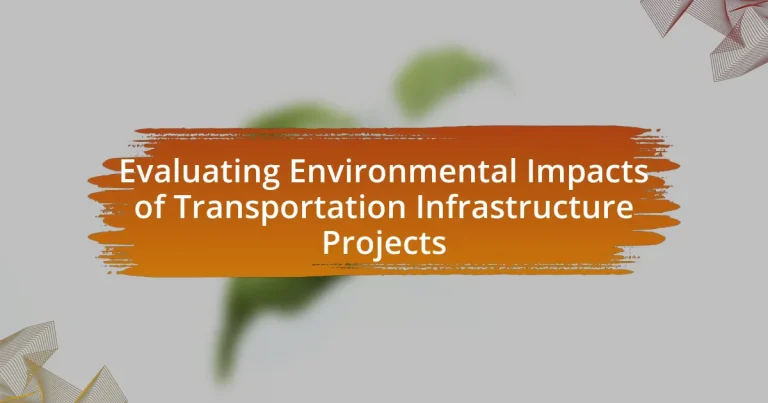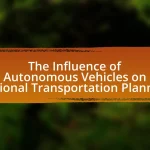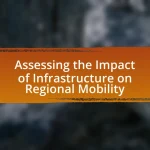Transportation infrastructure projects significantly impact the environment, leading to habitat destruction, air and water pollution, and increased greenhouse gas emissions. These projects disrupt ecosystems, contribute to air quality degradation through vehicle emissions, and contaminate water bodies with runoff from construction activities. The article evaluates the environmental impacts of transportation projects, including methodologies for assessment, the role of Environmental Impact Assessments (EIAs), and strategies for stakeholder engagement. It also discusses best practices for minimizing negative effects, such as sustainable design principles and the use of technology, while highlighting the challenges faced in evaluating and mitigating these impacts.
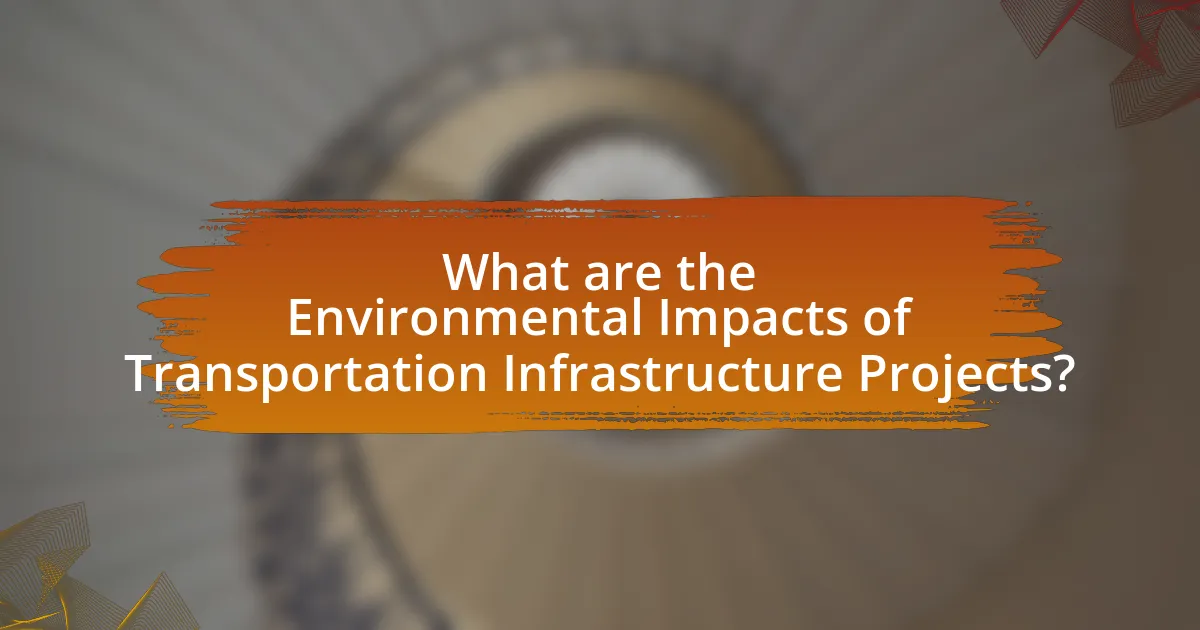
What are the Environmental Impacts of Transportation Infrastructure Projects?
Transportation infrastructure projects have significant environmental impacts, including habitat destruction, air and water pollution, and increased greenhouse gas emissions. These projects often require land clearing, which disrupts ecosystems and displaces wildlife. For instance, the construction of highways can fragment habitats, making it difficult for species to migrate and find food. Additionally, the operation of transportation systems contributes to air pollution through vehicle emissions, which can lead to health issues in nearby communities. According to the Environmental Protection Agency, transportation accounts for approximately 29% of total greenhouse gas emissions in the United States, highlighting its role in climate change. Furthermore, runoff from roads and construction sites can contaminate local water bodies, affecting aquatic life and drinking water sources.
How do transportation infrastructure projects affect air quality?
Transportation infrastructure projects can significantly affect air quality by increasing vehicle emissions during construction and operation phases. For instance, the development of new roads or transit systems often leads to higher traffic volumes, which can elevate levels of nitrogen oxides and particulate matter in the air. A study by the Environmental Protection Agency indicates that transportation contributes to approximately 29% of total greenhouse gas emissions in the United States, highlighting the direct link between infrastructure projects and air pollution. Additionally, construction activities can release dust and other pollutants, temporarily degrading air quality in surrounding areas.
What pollutants are commonly associated with transportation projects?
Transportation projects are commonly associated with pollutants such as nitrogen oxides (NOx), particulate matter (PM), carbon monoxide (CO), volatile organic compounds (VOCs), and sulfur dioxide (SO2). These pollutants primarily originate from vehicle emissions, construction activities, and the use of materials in road building. For instance, according to the Environmental Protection Agency (EPA), transportation contributes significantly to air pollution, with motor vehicles being a major source of NOx and PM, which are linked to respiratory issues and environmental degradation.
How do emissions from construction activities impact local environments?
Emissions from construction activities significantly impact local environments by contributing to air pollution, greenhouse gas emissions, and noise pollution. These emissions primarily consist of particulate matter, volatile organic compounds, and carbon dioxide, which can degrade air quality and harm public health. For instance, a study by the U.S. Environmental Protection Agency indicates that construction activities can release up to 1.5 million tons of particulate matter annually, exacerbating respiratory issues in nearby populations. Additionally, construction emissions contribute to climate change, as carbon dioxide is a major greenhouse gas, with the construction sector accounting for approximately 39% of global carbon emissions. This combination of air quality degradation and climate impact underscores the critical need for sustainable construction practices to mitigate these environmental effects.
What effects do transportation projects have on water resources?
Transportation projects can significantly impact water resources by altering hydrology, increasing pollution runoff, and affecting aquatic ecosystems. These projects often involve land clearing and the construction of impervious surfaces, which can lead to increased surface runoff and reduced groundwater recharge. For instance, a study by the U.S. Environmental Protection Agency indicates that urbanization from transportation infrastructure can increase runoff by 50% or more, leading to higher flood risks and sedimentation in water bodies. Additionally, pollutants such as oil, heavy metals, and nutrients from roadways can contaminate nearby water sources, adversely affecting water quality and aquatic life.
How can runoff from construction sites affect nearby water bodies?
Runoff from construction sites can significantly degrade nearby water bodies by introducing pollutants such as sediment, heavy metals, and nutrients. These pollutants can lead to increased turbidity, which reduces light penetration and affects aquatic plant growth. Additionally, sediment can smother habitats for fish and other aquatic organisms, disrupting the ecosystem. Studies indicate that construction site runoff can increase nutrient levels, leading to algal blooms that deplete oxygen in the water, harming aquatic life. For example, the Environmental Protection Agency (EPA) has reported that sediment is one of the leading causes of water quality impairment in the United States, underscoring the critical impact of runoff from construction activities on water bodies.
What measures can be taken to mitigate water pollution during construction?
To mitigate water pollution during construction, implementing erosion and sediment control measures is essential. These measures include installing silt fences, sediment basins, and erosion control blankets to prevent soil runoff into water bodies. According to the Environmental Protection Agency (EPA), proper management of stormwater runoff can significantly reduce pollutants entering waterways, with studies showing that effective sediment control can decrease sediment discharge by up to 90%. Additionally, using non-toxic materials and ensuring proper waste disposal further minimizes the risk of contaminating water sources during construction activities.
In what ways do transportation projects influence biodiversity?
Transportation projects influence biodiversity primarily through habitat fragmentation, pollution, and the introduction of invasive species. Habitat fragmentation occurs when roads and railways divide ecosystems, isolating wildlife populations and disrupting migration patterns. For instance, a study published in “Ecological Applications” found that roads can reduce animal movement by up to 80%, leading to decreased genetic diversity. Pollution from transportation activities, including runoff and emissions, can degrade air and water quality, adversely affecting plant and animal health. Additionally, transportation projects can facilitate the spread of invasive species, which outcompete native flora and fauna, further threatening biodiversity. Research indicates that road construction can increase the likelihood of invasive species establishment by providing new pathways for their dispersal.
How do roadways and railways fragment habitats?
Roadways and railways fragment habitats by creating physical barriers that disrupt the continuity of ecosystems. These infrastructures divide landscapes, isolating wildlife populations and limiting their movement, which can lead to decreased genetic diversity and increased mortality rates. Studies have shown that species such as amphibians and mammals are particularly vulnerable to habitat fragmentation caused by transportation networks, as they rely on connected habitats for foraging, mating, and migration. For instance, a study published in “Ecological Applications” by Forman and Alexander (1998) highlights that roads can reduce animal populations by up to 80% in fragmented areas, demonstrating the significant impact of transportation infrastructure on habitat integrity.
What species are most at risk from transportation infrastructure development?
Species most at risk from transportation infrastructure development include amphibians, reptiles, and large mammals. These groups are particularly vulnerable due to habitat fragmentation, road mortality, and barriers to movement. For instance, amphibians like the California red-legged frog and reptiles such as the Eastern box turtle face significant threats from roads that disrupt their breeding and foraging habitats. Large mammals, including the Florida panther, are also at risk as transportation networks can isolate populations and reduce genetic diversity. Studies have shown that road construction can lead to a 90% decline in certain species’ populations within affected areas, highlighting the severe impact of infrastructure development on biodiversity.
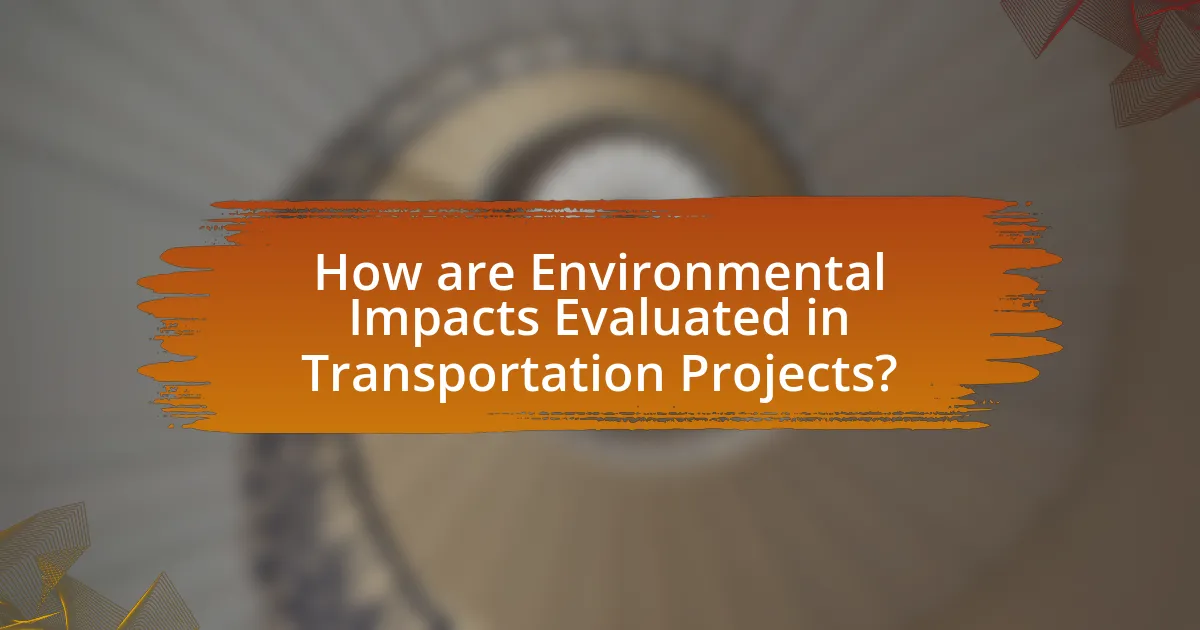
How are Environmental Impacts Evaluated in Transportation Projects?
Environmental impacts in transportation projects are evaluated through a systematic process known as Environmental Impact Assessment (EIA). This process involves identifying, predicting, and assessing the potential environmental effects of proposed transportation projects, including impacts on air quality, water resources, wildlife, and ecosystems.
The evaluation typically includes public consultations, data collection, and analysis of alternatives to minimize adverse effects. For instance, the National Environmental Policy Act (NEPA) mandates federal agencies in the United States to prepare detailed EIA reports for major projects, ensuring that environmental considerations are integrated into decision-making. This structured approach helps to ensure that transportation projects are developed sustainably and responsibly.
What methodologies are used to assess environmental impacts?
Methodologies used to assess environmental impacts include Environmental Impact Assessments (EIA), Life Cycle Assessments (LCA), and Strategic Environmental Assessments (SEA). EIA evaluates the potential environmental effects of proposed projects before they are carried out, ensuring that decision-makers consider environmental impacts. LCA analyzes the environmental aspects and potential impacts associated with a product or service throughout its life cycle, from raw material extraction to disposal. SEA is a systematic process that evaluates the environmental consequences of proposed policies, plans, or programs, promoting sustainable development. These methodologies are widely recognized and utilized in various sectors to ensure comprehensive evaluation of environmental impacts.
What role do Environmental Impact Assessments (EIAs) play?
Environmental Impact Assessments (EIAs) play a critical role in identifying, predicting, and evaluating the potential environmental effects of proposed transportation infrastructure projects. EIAs facilitate informed decision-making by providing a systematic process that assesses the environmental consequences before project approval. For instance, the National Environmental Policy Act (NEPA) in the United States mandates EIAs for federal projects, ensuring that environmental considerations are integrated into the planning and decision-making processes. This legal framework has led to the identification of significant impacts, such as habitat destruction and air quality degradation, allowing for mitigation strategies to be developed and implemented.
How is public participation integrated into the evaluation process?
Public participation is integrated into the evaluation process of transportation infrastructure projects through structured engagement methods such as public meetings, surveys, and stakeholder workshops. These methods allow community members to provide input on project impacts, preferences, and concerns, ensuring that diverse perspectives are considered in decision-making. For instance, the National Environmental Policy Act (NEPA) mandates public involvement in the environmental review process, requiring agencies to solicit feedback from affected communities. This integration enhances transparency, fosters trust, and leads to more informed and acceptable project outcomes.
What are the key indicators of environmental impact in transportation projects?
Key indicators of environmental impact in transportation projects include air quality, greenhouse gas emissions, noise pollution, land use changes, and water quality. Air quality is assessed by measuring pollutants such as nitrogen oxides and particulate matter, which can be significantly affected by vehicle emissions. Greenhouse gas emissions are quantified in terms of carbon dioxide equivalents, reflecting the project’s contribution to climate change. Noise pollution is evaluated through decibel levels, which can impact nearby communities and wildlife. Land use changes are analyzed by examining alterations to habitats and urban sprawl, while water quality is monitored for runoff and contamination from construction activities. These indicators provide a comprehensive framework for assessing the environmental consequences of transportation infrastructure projects.
How do noise levels factor into environmental evaluations?
Noise levels are a critical factor in environmental evaluations, particularly in the context of transportation infrastructure projects. These evaluations assess the potential impact of noise pollution on human health, wildlife, and overall community well-being. Research indicates that prolonged exposure to high noise levels can lead to adverse health effects, including stress, sleep disturbances, and cardiovascular issues, as documented by the World Health Organization in their guidelines on environmental noise. Furthermore, noise can disrupt wildlife behavior, affecting species’ communication, mating, and feeding patterns, which is essential for biodiversity conservation. Therefore, incorporating noise level assessments into environmental evaluations ensures that the potential impacts on both human populations and ecosystems are thoroughly considered and mitigated.
What metrics are used to assess habitat disruption?
Metrics used to assess habitat disruption include species diversity indices, habitat fragmentation measurements, and ecological integrity assessments. Species diversity indices, such as the Shannon-Wiener index, quantify the variety of species in a given area, indicating the health of the ecosystem. Habitat fragmentation measurements evaluate the degree to which habitats are divided into smaller, isolated patches, which can affect species movement and genetic diversity. Ecological integrity assessments examine the overall condition of an ecosystem, considering factors like species composition, structure, and function. These metrics provide a comprehensive understanding of how transportation infrastructure projects impact habitats, supported by studies that demonstrate correlations between these metrics and biodiversity outcomes.

What Best Practices Can Be Implemented to Minimize Environmental Impacts?
Implementing best practices such as conducting thorough environmental impact assessments (EIAs), utilizing sustainable materials, and promoting public transportation can significantly minimize environmental impacts. EIAs help identify potential adverse effects before project initiation, allowing for mitigation strategies to be developed. The use of sustainable materials reduces resource depletion and pollution, while promoting public transportation decreases reliance on personal vehicles, leading to lower greenhouse gas emissions. According to the U.S. Environmental Protection Agency, transportation accounts for approximately 29% of total greenhouse gas emissions, highlighting the importance of these practices in reducing environmental footprints.
How can sustainable design principles be applied to transportation projects?
Sustainable design principles can be applied to transportation projects by integrating eco-friendly materials, optimizing energy efficiency, and promoting multimodal transportation options. For instance, using recycled materials in road construction reduces resource consumption and waste. Additionally, implementing energy-efficient technologies, such as LED street lighting and electric vehicle charging stations, minimizes energy use and greenhouse gas emissions. Furthermore, designing infrastructure that supports public transit, cycling, and walking encourages reduced reliance on single-occupancy vehicles, which can lead to lower traffic congestion and improved air quality. These strategies collectively contribute to minimizing the environmental impacts associated with transportation infrastructure projects.
What are the benefits of using green infrastructure in transportation planning?
The benefits of using green infrastructure in transportation planning include enhanced environmental sustainability, improved stormwater management, and increased biodiversity. Green infrastructure, such as permeable pavements and green roofs, reduces runoff and mitigates flooding by allowing water to infiltrate the ground, which is supported by studies showing that green infrastructure can reduce stormwater runoff by up to 65%. Additionally, incorporating vegetation in transportation corridors can improve air quality and provide habitat for wildlife, contributing to urban biodiversity. Research indicates that cities implementing green infrastructure can experience a reduction in urban heat islands, leading to lower energy consumption for cooling.
How can technology improve environmental outcomes in transportation projects?
Technology can improve environmental outcomes in transportation projects by enabling more efficient resource management and reducing emissions. For instance, the implementation of smart traffic management systems can optimize traffic flow, leading to decreased fuel consumption and lower greenhouse gas emissions. According to a study by the Texas A&M Transportation Institute, intelligent transportation systems can reduce travel time by up to 25%, which directly correlates with reduced vehicle emissions. Additionally, the use of electric and hybrid vehicles, supported by advancements in battery technology, significantly lowers air pollutants compared to traditional gasoline-powered vehicles. Furthermore, Geographic Information Systems (GIS) can assist in planning and assessing the environmental impacts of transportation projects, ensuring that infrastructure development minimizes ecological disruption. These technological advancements collectively contribute to more sustainable transportation practices.
What strategies can be employed to engage stakeholders in minimizing impacts?
To engage stakeholders in minimizing impacts, strategies such as inclusive communication, collaborative decision-making, and transparent reporting can be employed. Inclusive communication ensures that all relevant stakeholders, including local communities, government agencies, and environmental groups, are informed and have opportunities to express their concerns and suggestions. Collaborative decision-making involves stakeholders in the planning and implementation processes, fostering a sense of ownership and responsibility towards minimizing environmental impacts. Transparent reporting of project goals, progress, and environmental assessments builds trust and encourages ongoing stakeholder involvement. These strategies are supported by research indicating that stakeholder engagement leads to more sustainable outcomes in transportation infrastructure projects, as seen in case studies like the Federal Highway Administration’s guidelines on stakeholder involvement.
How can community feedback shape transportation project planning?
Community feedback can significantly shape transportation project planning by ensuring that projects align with the needs and preferences of local residents. Engaging the community allows planners to gather insights on potential environmental impacts, traffic patterns, and accessibility issues, which can lead to more sustainable and effective transportation solutions. For instance, studies have shown that projects incorporating community input are more likely to achieve higher levels of public support and usage, as evidenced by the success of the Seattle Transit Master Plan, which integrated extensive public feedback to enhance transit accessibility and reduce environmental impacts.
What role do partnerships play in enhancing environmental stewardship?
Partnerships play a crucial role in enhancing environmental stewardship by facilitating collaboration among diverse stakeholders, including government agencies, non-profit organizations, and private sector entities. These collaborations enable the sharing of resources, expertise, and best practices, which leads to more effective environmental management strategies. For instance, partnerships can result in joint initiatives that promote sustainable practices, such as reducing carbon emissions and protecting natural habitats. Evidence of this can be seen in projects like the Sustainable Transportation Partnership, which has successfully implemented eco-friendly transportation solutions through collective efforts, demonstrating that collaborative approaches yield significant environmental benefits.
What are the common challenges faced in evaluating and mitigating environmental impacts?
Common challenges in evaluating and mitigating environmental impacts include data uncertainty, stakeholder engagement, and regulatory compliance. Data uncertainty arises from incomplete or inaccurate information about environmental conditions, making it difficult to assess potential impacts accurately. Stakeholder engagement is challenging due to diverse interests and conflicting priorities among communities, government agencies, and project developers, which can complicate consensus-building. Regulatory compliance presents difficulties as environmental laws and regulations can vary significantly across jurisdictions, leading to complex permitting processes and potential delays. These challenges are documented in studies such as the “Environmental Impact Assessment: A Guide to Best Practice” by the International Association for Impact Assessment, which highlights the importance of addressing these issues for effective environmental management.
